The other day, my sister and niece stopped in at a thrift shop (or “op shop”), and they came across this embroidered Chinese panel that they thought I might find interesting. It was only a couple bucks, so they brought it home to me.
The embroidery on the panel looks to me as if it were worked by hand, but it has that kind of mass-produced look (sweatshop work, perhaps?). I could be wrong. I’d be happy to hear what you all think.
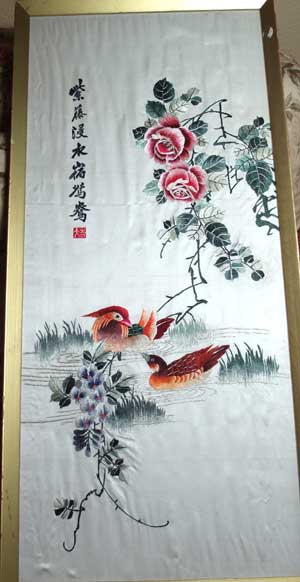
The frame is flimsy and cheaply made and painted. I think the embroidery is actually stuck on the board in parts. I’m going to take it apart, eventually, just to see what it’s all about.
There are parts of the embroidery that I really like:
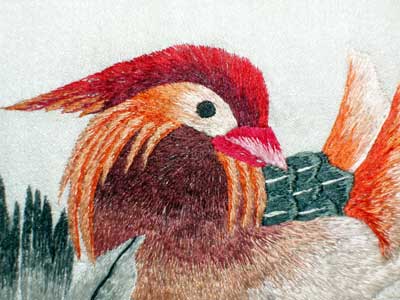
The shading on the water fowl is magnificently done!
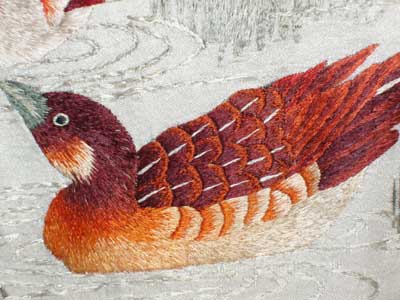
The feathers and the layers of color are finely and perfectly stitched. There aren’t any “carrying threads” that are typical to machine embroidery. I’m certain this is hand stitched.
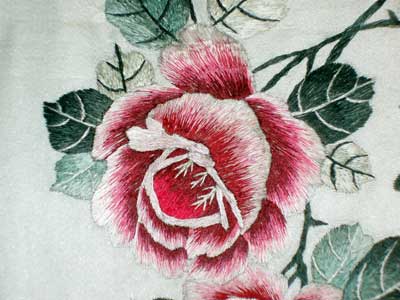
The roses up close didn’t really grab me at first. The contrasts are stark and the lines a bit angular…
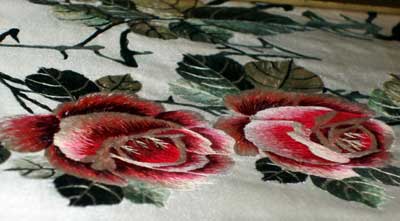
But what’s funny is that, from the side, they look entirely different! The silk has quite a sheen to it, too.
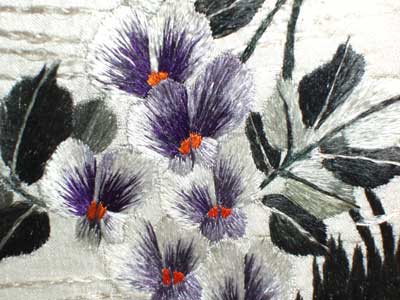
The clusters of flowers and leaves below the ducks are the best part of the foliage on the piece, I think.
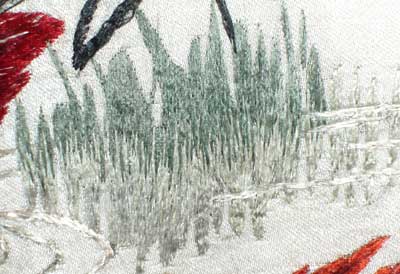
And the grass and water on the pond in which the ducks are floating is really interesting. The two shades used to embroider the grass give the illusion of a reflection, and the pale grey horizontal stitches make the water look quite real.
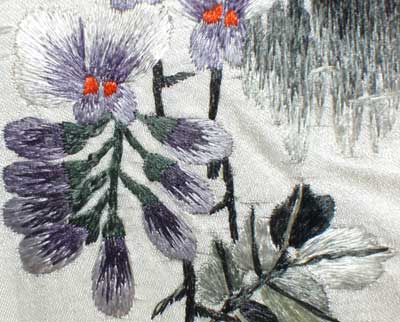
This little bunch of hanging buds and flowers makes a nice cluster, and I like the silvery grey in the leaves.
There are some stains on part of the piece – mostly in the foliage hanging down from the roses – but other than that, it’s pretty clean.
So, what do you reckon? Shall I take it apart? I was thinking there might be parts that would be fun to salvage, recycling it into something else. Any ideas?







Oooo, this reminds me of a few pieces that I have seen hanging somewhere that I could get up close enough and try my darnedest to figure out whether it’s handwork or mass produced. I would take your word that this is hand done and you would definitely being doing it a great justice by taking that dated frame off and giving it new life.
What a treat,
Tammy
I'm pretty sure this is hand done, too. The motifs are very like Japanese embroidery and the colors are interesting. (See the JE website for phase pieces.) It is probably done commercially for export, but the embroiderers are really skilled. I think the "roses" are actually camelias. I'd take it apart & reframe or reuse. Great find. AnneG in NC
I wouldn’t do anything to destroy the integrity of the piece. I saw Chinese embroidery at a China exhibit in the ’80’s that was amazing. They have embroiderers that are considered national treasures. This could be really old and just poorly cared for.
I wouldn’t cut the piece. I think you would be destroying the integrity of the overall composition. Whether hand embroidered or machine embroidered, someone went to great lengths to create a balanced work of art. That person had a deep understanding of color, composition, form, texture and shape. Your eye moves around the piece in a fluid motion. Cutting the piece would destroy that delightful aspect of the embroidery. Perhaps recreating certain motifs for yourself would be a fun project. If you particularly like the violets or the bird, for example, maybe you can use the piece as inspiration for your own work. That’s my most humble opinion.
Hi, Mary!
You might check with Pat Dalton (daltontours.com). She is an expert in Chinese embroidery. She has traveled there extensively and that is what her entire focus is on.
Blessings, North Idaho Connie
I like this piece…tho’ one would definately want to see it out of that frame, and washed and pressed.It would seem a shame to cut it up,if it looks good off the board…and if you reframe it you could maybe take an inch or two off the top? See what it scrubs up like first I guess.Nice find!
no se si llegue …para mi es un lindo bordado a mano… lindos colores puntadas apropiadas.bordadora con mucha clase ….si fuese mio hooo
las flores son rosas
que bien poder admirar
gracias maria
rosaly
no se si llegue …para mi es un lindo bordado a mano… lindos colores puntadas apropiadas.bordadora con mucha clase ….si fuese mio hooo
las flores son rosas
que bien poder admirar
gracias maria
rosaly
I would take it apart and wash it and see how it turns out. If you thought you would use it in a new frame fine – otherwise as a cq gal I can see all the indidividual pieces(includingth Chinese writing) incorporated into a beautiful oriental wallhanging. I feel when you are making something new that you will enjoy out of old fabrics you are giving it new life in many instances.
Hugs
FredaB
I would say they were done by hand. This is what I was talking about when you had your new frame build when I said that I’d seen similar in a video about japanese traditional crafts. They tend to havea huge role of silk out so that multiple people can work on it, the pattern is inked by hand and then stitched. If you watch the professional artisans they work very quickly using both hands and can complete large designs fairly quickly. This is also how all the embroidery on kimonos is done.
It does have some pretty elements. My two thoughts…
IIRC, there was a big Chinese expo at the KS state fair a long time ago. (Carlin was still governor! Is my age showing?) There was a lot of fabrics, crafts, carved jade, etc available for purchase. Maybe it came from there?
I’ve seen things like this as a set, with a large design split into three or four panels. If the set is already broken up, it wouldn’t be any further transgression to recycle this part into something to be used or loved.
I had the video I mentioned in my last post bookmarked on another computer so here it is. Edo-shishū (Edo-style embroidery) – Video one shows inking the design near the end. Video 2 shows setting up 2 types of frames, and then after that is the embroidery itself. Hope it is of interest.
I have done japanses embroidery by hand,I would reframe it and put glass on it I think this is silk and exmily well done chineses and japanses children learn this type of stiching very younge age so by the time they are adults they teach those of us .I can only dream of making something so bearth taking .chinses take silk and spit it into thiner strands then a human hair then stich with it good luck no matter what you do with it.